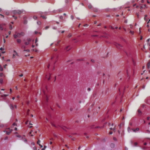The authors concluded their paper by suggesting that aggressive serum acid-lowering approaches may be helpful in slowing the progression of renal disease.
Lara C. Pullen, PhD, is a medical writer based in the Chicago area.
ad goes here:advert-1
ADVERTISEMENT
SCROLL TO CONTINUE
Reference
- Desai RJ, Franklin JM, Spoendlin-Allen J, et al. An evaluation of longitudinal changes in serum uric acid levels and associated risk of cardio-metabolic events and renal function decline in gout. PLoS One. 2018 Feb 28;13(2):e0193622. eCollection 2018.

